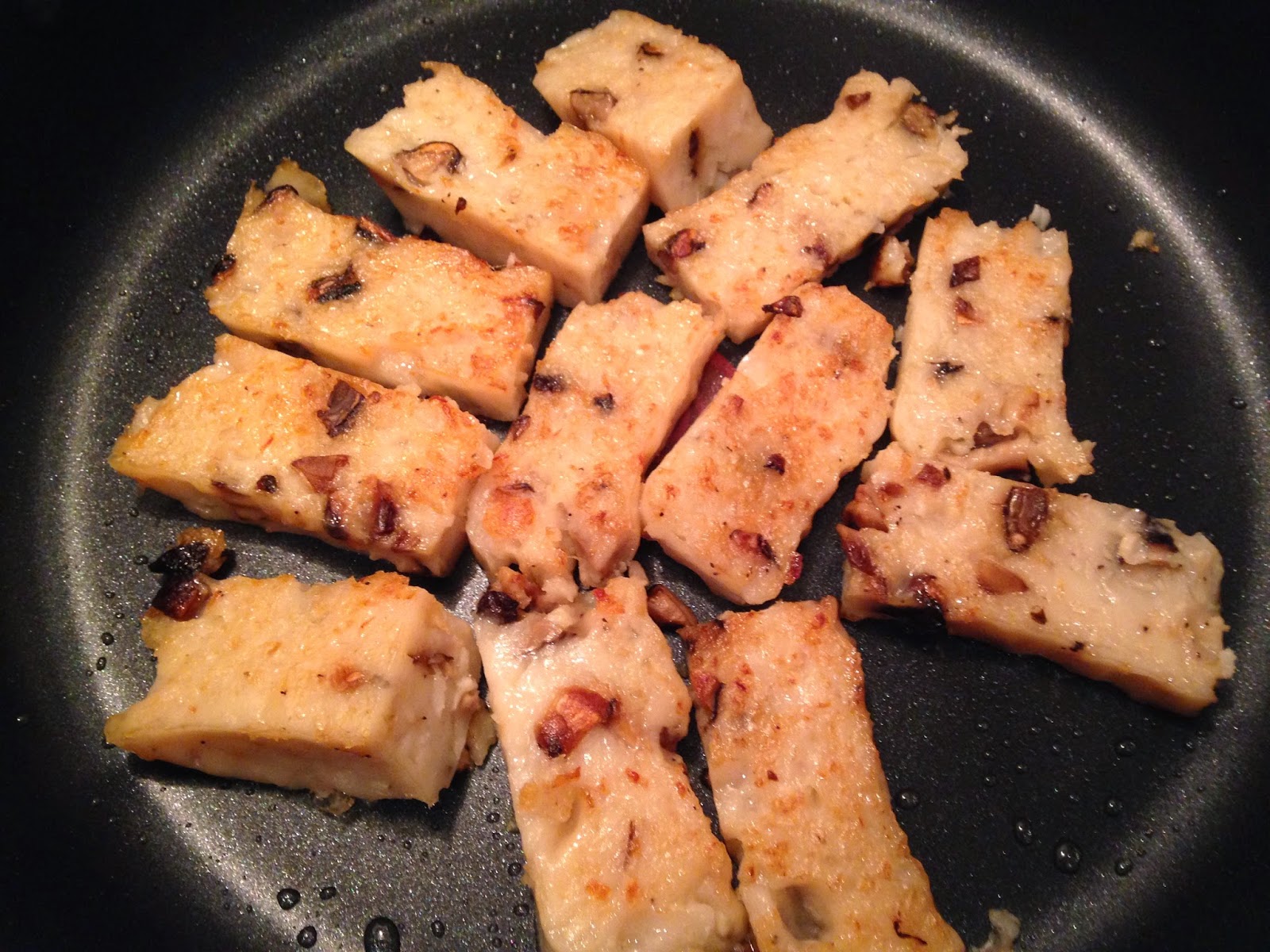One of my favorite dishes at dim sum is Chinese Turnip Cake. It is also commonly referred as Lo Bak Gou or Luo Bo Gao. For Chinese New Year, families will often eat Turnip Cake to have good fortune for the upcoming year.
I have always purchased store bought Chinese Turnip Cake for Chinese New Year and pan fried it at home. This is the first year I made Turnip Cake from scratch.
My mother in law has made Lo Bak Gaw many times so I sought her expertise. Based on her description of the process, it did not appear to be hard, but it sounded like it did required a bit of prep work.
With her encouragement and a quick Internet search, I found a recipe that is relatively easy to execute if you follow the steps closely. Since I did not have an 8 inch cake or souffle pan, I used my 6 inch cake pan instead and made two Turnip Cakes.
Making your own Turnip Cake requires more work, but it tastes much better than any store bought version.
Ingredients
1 large Chinese white turnip (about 2 pounds)
8 large Chinese dried shitake mushrooms
1/2 cup Chinese dried shrimp
2 tbsp vegetable oil
2 tsp Chinese rice cooking wine (like Shaoxing Cooking Wine)
1 tsp sugar
1 tsp salt
2 cups rice flour (commonly found at Asian markets)
Directions
1. Peel the turnip and grate (or cut into thin matchsticks) so it makes up 4-1/2 cups.
2. In a large pot, combine the grated turnip and 1 quart (or just under 1 litre) of cold water, bring to a boil over high heat. Reduce heat to low, cover, and simmer for 30 minutes or until the turnip is tender. Drain, reserve 1 cup of the cooking liquid.
3. In bowl, soak the shitake mushrooms with enough hot water to cover. Cover the bowl with a plate and let the mushrooms soak for at least 30 minutes or until the mushrooms are soft.
4. In another bowl, soak the dried shrimp in 1/2 cup cold water for 30 minutes or until it is softened.
5. Set the mushrooms aside and filter the mushroom soaking liquid through a sieve lined with a coffee filter or cheesecloth. Reserve 1/2 cup of the mushroom liquid. Wash mushrooms under running water and squeeze dry. Dice the mushrooms. Set aside.
6. Drain the dried shrimp and reserve 1/2 cup of the soaking liquid. Finely chop the dried shrimp and set aside.
7. In a wok or skillet over medium heat, add the vegetable oil.
8. Add in diced mushrooms, shrimp and stir fry for 2 to 3 minutes until the mushroom is soft and the shrimp is fragrant.
9. Pour in the rice cooking wine, sugar and stir to combine.
10. Add the cooked drained turnip to the skillet. Stir to combine.
11. In a large bowl, mix the rice flour, 1/2 cup of
each of the reserved mushroom soaking liquid
and shrimp soaking liquid. Stir until the batter is smooth. Then stir in 1 cup of the hot turnip broth.
12. Pour the batter into the skillet, add salt and stir until combined. The batter will have the texture of rice pudding.
13. Line the bottom of an 8 inch cake pan (or souffle dish with straight sides) with a piece of parchment paper.
14. Pour the batter into the cake pan. Smooth the batter with a spatula.
15. Bring water to a boil in a large steamer or a pot large enough to fit the cake pan without touching the sides. Carefully place the pan into the steamer, cover, reduce heat to medium-low and steam for 1 hour or until the cake is just set and is firm to the touch. Make sure there is enough water and replenish with hot water if necessary.
16. Remove the pan from the steamer and allow it to cool for an hour in a sink filled with cold water.
17. Cover with plastic wrap and refrigerate for at least 3 to 4 hours.
18. Run a flat spatula along the edge of the cake to loosen the sides.
19. Invert to unmold. Peel off the wax paper, wrap in plastic wrap and refrigerate until ready to use.
To serve
1. Slice the cake in half and cut crosswise into 1/2 inch thick slices.
2. In a large skillet, heat 2 tbsp of vegetable oil over medium heat until the pan is hot.
3. Place the turnip cake slices into the skillet and cook each side until it is golden brown and crispy. Flip to cook the other side.
4. Serve hot on its own or with oyster sauce and sriracha hot sauce.
Source: Slightly adapted from
Epicurious
























%2B3.jpg)
+1.jpg)
%2B2.jpg)
+10.jpg)
+11.jpg)
%2B4.jpg)
%2B8.jpg)
%2B5.jpg)
%2B9.jpg)
















